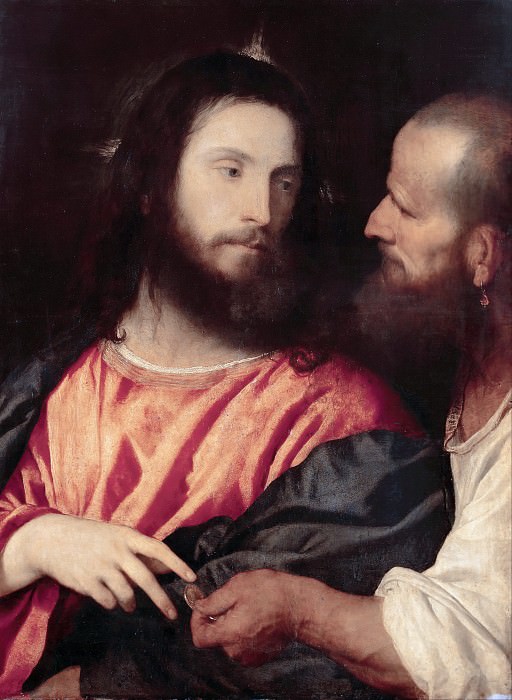The Tribute Money Titian (Tiziano Vecellio) (1488/90-1576)
Titian – The Tribute Money
Edit attribution
Download full size: 3060×4188 px (3,3 Mb)
Painter: Titian (Tiziano Vecellio)
Location: Old Masters Picture Gallery (Gemäldegalerie Alte Meister), Dresden.
Titian created his grandiose canvas especially for the Ferrara of Alfonso d’Este. The customer himself suggested the subject of this creation. At this time the struggle with the popes was underway, and the slogan chosen for it was that Caesar should be paid what was due to him. Titian was stirred by the philosophical depth of this famous subject. As early as the 15th century, Leonardo was able to contrast the baseness and nobility of man.
Description of Titian Vechellio’s Dinarius of Caesar
Titian created his grandiose canvas especially for the Ferrara of Alfonso d’Este. The customer himself suggested the subject of this creation. At this time the struggle with the popes was underway, and the slogan chosen for it was that Caesar should be paid what was due to him.
Titian was stirred by the philosophical depth of this famous subject. As early as the 15th century, Leonardo was able to contrast the baseness and nobility of man. Titian also sensed these contradictions characteristic of his time. In his frescoes, dark and light forces collide.
In his Dinarius of Caesar this contradiction is resolved differently. We feel the great depth of the psychological plan. The theme becomes universal and acquires the loudest possible sound.
The Pharisees decided to kill Christ by all means. They were afraid to kill Him. They devised a whole plan. A man with a dinar was sent to Christ. He asked him if Caesar had to pay taxes.
This question was a trap. If he answered "yes", the whole population of Judea would be against him. If he answered "no," the Roman authorities would surely punish him. But Christ did something different. He asked the Pharisee what was on the coin he had brought. The man was surprised and replied that there was God on one side and Caesar on the other. It was after this that the phrase was uttered that everyone should get what was due to him.
The picture is very simple. The artist simply juxtaposed the two men. There is no drama in it. The figures are monumental, there are no details. All the attention is concentrated on the characters. The images are very capacious and maximally focused. Christ fills in almost the entire canvas. He stands out against the background of red and blue.
Titian conveyed the theme of a meeting of completely opposite worlds: the ideal and the real.
Кому понравилось
Пожалуйста, подождите
На эту операцию может потребоваться несколько секунд.
Информация появится в новом окне,
если открытие новых окон не запрещено в настройках вашего браузера.
You need to login
Для работы с коллекциями – пожалуйста, войдите в аккаунт (open in new window).




















COMMENTS: 1 Ответы
дИнарий
You cannot comment Why?
On the right, an older man with a prominent nose and a beard, wearing a simple white tunic, leans in towards the first figure. He holds a coin in his right hand, which he is presenting or placing into the first mans outstretched fingers. His gaze is directed at the coin or the interaction.
The subtext of the painting revolves around a pivotal moment from the Gospels, specifically the encounter where Christ is asked whether it is lawful to pay taxes to Caesar. Christs famous reply, Render therefore unto Caesar the things which be Caesars; and unto God the things that be Gods, is encapsulated in this scene.
The painting visually explores the tension between earthly authority (represented by the coin and the tax collector or questioner) and spiritual authority (represented by Christs divine presence and teachings). The rich color and texture of Christs robe contrast with the more subdued attire of the other figure, perhaps subtly emphasizing divine superiority. Christs calm, knowing expression suggests he is not merely responding to a legal question but is guiding the questioner towards a deeper understanding of his role in both the material and spiritual realms. The act of handing over the coin can be interpreted as a concession to worldly laws while simultaneously asserting that ultimate allegiance belongs to God.